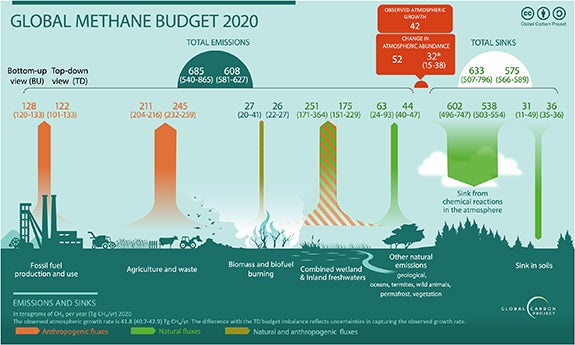The world faces an uphill battle against methane emissions, a potent greenhouse gas driving climate change at unprecedented rates. While over 150 nations have pledged to reduce methane by 30% this decade, global emissions have risen faster than ever over the past five years.
Methane’s impact on global warming is profound. It is the second most significant anthropogenic greenhouse gas after carbon dioxide and contributed 0.5°C of warming during the 2010s compared to the late 1800s. Its global warming potential (GWP) surpasses CO2, heating the atmosphere over 80 times faster within 20 years of release.
These staggering statistics underscore the urgency of addressing methane emissions to mitigate the worst effects of climate change.
Methane levels in the atmosphere are now over 2.6 times higher than pre-industrial levels—the highest in at least 800,000 years. In January 2024, average global methane concentrations reached 1931 parts per billion (ppb), with annual increases accelerating at an alarming rate.

Between 2020 and 2023, atmospheric methane rose by 15, 18, 13, and 10 ppb respectively, some of the largest increases recorded since the U.S. NOAA began its time series in 1983.
The Global Methane Budget, a collaborative effort led by the Global Carbon Project and published IOP Science, sheds light on methane sources and sinks. Its recent data reveals that human activities like coal mining, oil and gas production, livestock farming, and waste decomposition contributed nearly 400 million tons—or 65%—of global methane emissions in 2020.
Agriculture and waste together produced twice as much methane as the fossil fuel sector that year. These human-driven emissions have continued to grow, with notable regional increases in China and Southeast Asia.
Conversely, only the European Union and Australia appear to have reduced their methane output over the past two decades. The stark disparity underscores the uneven progress among nations in combating methane emissions.
Related Stories
Methane’s rising concentrations coincide with worsening climate events. In 2023, global average surface temperatures reached a record high of 1.45± 0.12°C above pre-industrial levels. This milestone marks the brink of a 1.5°C increase, beyond which climate impacts are expected to intensify dramatically.
Extreme weather patterns have already emerged. Canadian wildfires scorched 18.5 million hectares in 2023—nearly triple the previous record. Amazon River levels dropped to 120-year lows, with surface water temperatures nearing 40°C in some areas. These crises illustrate the cascading consequences of warming driven, in part, by surging methane emissions.
“This trend cannot continue if we are to maintain a habitable climate,” researchers cautioned in Environmental Research Letters. The paper’s lead author, Rob Jackson, highlighted that unchecked methane emissions could push global temperatures above 3°C by the century’s end. He likened current climate goals to a mirage, saying, “Right now, the goals of the Global Methane Pledge seem as distant as a desert oasis.”

New research is redefining our understanding of methane emissions from natural sources. Historically, wetlands, lakes, and rivers were classified as natural methane emitters. However, recent analyses reveal that human activities significantly amplify emissions from these environments.
Reservoirs created by dams, for example, release an estimated 30 million tons of methane annually as submerged organic matter decomposes.
Additional human-driven factors include fertilizer runoff, wastewater, and land-use changes. Together, these influences account for about one-third of methane emissions from wetlands and freshwater systems in recent years. “Emissions from reservoirs are as much a direct human source as methane from cows or oil fields,” Jackson remarked.
The interplay of these factors complicates the global methane budget, an accounting framework that tracks sources and sinks of the gas. The Global Carbon Project’s updated budget uses advanced satellite-based inversions, such as the TROPOspheric Monitoring Instrument (TROPOMI), to refine its estimates. These tools offer critical insights into regional and sectoral changes, informing strategies to curb emissions.

Despite the alarming trends, mitigation remains within reach. Methane’s relatively short atmospheric lifespan, about 12 years, makes it an ideal target for rapid climate action. Reducing methane emissions could slow warming more quickly than cuts to carbon dioxide alone.
Several nations have already made strides. The European Union has implemented stricter regulations on landfill emissions and agricultural practices. Similar policies could be expanded worldwide to address major sources like livestock and fossil fuels.
Technological innovations also offer promise. Methane capture systems at landfills and oil and gas facilities are gaining traction. Additionally, improved livestock feed additives can reduce methane emissions from cattle digestion. Combined with robust international cooperation, these measures could significantly curb methane levels in the coming decades.
As Jackson emphasized, “COVID changed nearly everything—from fossil fuel use to emissions of other gases that alter the lifetime of methane.” The pandemic illustrated how interconnected our actions are with atmospheric chemistry, offering both lessons and opportunities to reshape future policies.
Global collaboration is essential to meet the targets of the Global Methane Pledge and stabilize the climate. Addressing methane emissions will not only limit near-term warming but also alleviate the severe weather patterns already reshaping ecosystems and societies worldwide.
The path forward demands urgent action, but the tools and knowledge are within our grasp.
Note: Materials provided above by The Brighter Side of News. Content may be edited for style and length.
Like these kind of feel good stories? Get The Brighter Side of News’ newsletter.
The post The environment faces new threats from global methane emissions appeared first on The Brighter Side of News.